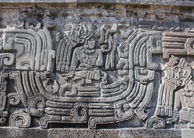Religion, Commodity, or Escape: Sports in Modern American Culture
By
2009, Vol. 1 No. 10 | pg. 1/1
KEYWORDS:
American sport has become far more than contests with rules played on fields, diamonds, or rinks. Our current conception of sport is more than just a ball moving between groups of athletes, or a struggle for a finish line, or an effort to impress judges, as various critical studies will attest. American sport has produced something more than just the usual trappings of sport that bleed into other aspects of society: the refereeing and record keeping, the public accounts of events, the hero worship of the victors, and the training of youth. American sport has produced, especially in the information age, a remarkable dialogue about sports. What was fifty years ago a sport section of a local newspaper and perhaps a radio hour, and later, a local news update, has become an entire wing in the marketplace of ideas. There are now twenty-four hour sports networks on radio and television, periodicals and books of every kind, and endless websites devoted to sports in all of its forms. Very few of these outlets are actually concerned with reporting about sporting events, at least in an objective sense. Especially with the sudden explosion of the blogosphere, the recent trend in sports is not simple enjoyment of the contests on some aesthetic level, but a constant need to debate and argue over the underlying meaning of the games. The forms these arguments take are as diverse as the games themselves. There are radio talk shows, devoted mostly to second guessing coaches and allowing fans to vent their frustrations on an emotional level. There are TV shows where panels of so-called experts debate increasingly hypothetical situations. There are those who seeks meaning in numbers, pouring over and creating new stats, and arguing which translate into indicators of real world success (baseball statisticians have even created a name for their increasingly complex field: sabermetrics). Then there are those who seek to disengage from the subjective experience of sports and seek to understand the field in an academic way that appreciates the sports place within society. All of these perspectives penetrate to different levels of sport, and all have their own functions, from the angry fan driving to work who needs a morning distraction and outlet, to the intellectual who uses sport to explore man’s social needs. What is interesting is that such a wide and diverse strata of society use sports, and the dialogue about sports, for so many different ends, and that they all presumably continue to find something of worth in those pursuits.What is it about sports, especially modern American sports, that brings so many different people into its domain? Sport is entertainment and has the ability to captivate many, but it creates allegiances and anxieties that go far deeper than the movie industry, for example. It has also been compared to religion, but it can never rise to the same level of importance for religious and non-religious people. Sport is also seen, more cynically, as an “opiate for the masses,” and a way in which power relationships are taught constructed for new generations who grow up playing and following them. Finally, sports has been described as a safe haven from the rest of societies struggles, as a place of transcendence and purity, an oasis of simplicity and verifiable truth in the rough complex desert of modern life. All of these perspectives give some clue to the phenomenon of sporting culture, but all of them ultimately fall short as an explanation in and of themselves. American sport is most certainly an industry, and wherever large amounts of capital are created and concentrated, both in the hands of the owners and the hands of athletes themselves, there is going to be society wide interest. American sport has become a mostly corporate entity, and athletes are essentially bought and sold on an open market. The intrinsic character building lessons that have long been held up as sports shining virtue have been replaced by corporate interests. D. Stanley Eitzen notes that sports have “been transformed from an activity for individuals involved in for sport for its own sake, to a money driven, corporate entity where sport is work rather than play, and where loyalty to players, coaches, and owners is quaint notion that is now rarely held.”1 Sports is increasingly becoming a product to be bought and sold, and the huge increase in sports dialogue can be seen as a testament to that. “It has come to the point,” Jay J. Coakley observes, “where participants can prove themselves in sport through their ability to consume as well as their ability to master physical skills.” 2 Although it is useful to look at modern sport as a commodity, it is not an all inclusive perspective. Many do still play sports for the sake of playing, and it would seem that judging sports as just another part of the entertainment industry misses much of the emotional connections, cultural bridges and cultural walls that sport creates and reinforces. To explain the depth of devotion to sport and various teams, sport is often analogously compared to organized religion, and the comparison is an apt one: sports has its saints and its devils, its shrines and its customs, its prayers (the concept of “rooting”), and like religion, sports both informs the culture at large and is molded by it. While it is easy to compare sports to religion, it is another thing to call sports a religion. But sports may very well be a kind of progeny of religion, as social function that has taken up the slack of religion’s retreat from modern society. “In industrial society, sport has overtaken many of the previous functions of an established patriarchal church and organized religion,” argues Varda Burstyn.3 However, sport lacks the most fundamental aspect of religion, the cosmological model, the map of existence that establishes the relationship between humanity and the cosmos. Allen Guttman has noted sports in primitive societies have always been linked with the divine, and it is only in modern sports where that link has been severed.4 It would seem that that ancestral divide between religion and sports mirrors the divide between the divine and society. Religion and sports, it would seem, are part of the same mode of social organization. Academics must develop a new overarching framework that puts both sports and religion under the same umbrella while clearly distinguishing the two. Another perspective on the place of sport in American society is that of a kind of oasis of truth. Sport has clear winners and losers, clear rules that gives an opportunity for us to view objective truth forged somewhere between brute physical force and aesthetic beauty captured by human form. The popular public conception is that sports create an equal playing field that strips away social and political advantages. “Modern sports assume equality,” Guttman declares.5 In a society like ours that prides itself on egalitarian values but is often forced to painfully confront its own inequalities and injustices, the allure of the sports as center of truth is particularly compelling. But as many scholars and sportswriters have demonstrated, sport is far more likely to reflect societal organization and hierarchies than to provide relief from them. In his famous essay on Balinese cockfighting, Clifford Geertz notes that cockfighting, a sport that pervades almost every aspect of Balinese culture, “is fundamentally a dramatization of status concerns.”6 He then proceeds to point out that these dramatizations effectively change nothing, the dramatization of them only enforce previously existing arrangements. “No ones status really changes” (italics his).7 This is reflective of the stasis within Balinese culture. In America sports do change participants social and economic station. But it happens very rarely, yet the dream of using sports to achieve fame and fortune is widespread, while the number of those who actually succeed are an almost infinitesimally small proportion. Yet this also serves to enforce American values, and perpetuate “the myth of meritocracy that justifies and reproduces social class structures.”8 This line of argument is taken up by many scholars, that sports perpetuates class, race, and gender distinctions. Much of it is convincing, but much of it ignores the fluidity of sports, and the opportunity for sports to become a place where social change can, thanks to the objective nature of athletic conflicts, win huge victories. For example, Coakley summarizes Hoch, who argues that sport reinforces the status quo and as evidence offers that “losses lead fans to call for new players and coaches—not a restructuring of the game or its rules.”9 Such an argument supposes that sports are rigid and concrete. But sports are the opposite; they are fluid and constantly evolving. Rule changes happen all the time, and anyone who watches the NBA, NFL or MLB today and compares it with the grainy footage of the past knows that the two versions of the game hardly resemble each other. Hoch’s analysis ignores the evolution of sports, an evolution that, far from enforcing the status quo, demonstrates the democratic nature of the marketplace. Rule changes are often instituted for the enjoyment of the fans, and for protection of players. Any analysis that ignores the way in which sport responds to the desires of its fan base is one too ideological to be taken seriously. Statements like this one made by Petryszak and cited by Coakley are nothing shot of inane: “the ultimate consequence of …spectator sports in society is the reduction of the population to a position of complete passivity”.10 Shifts in sport often give a stage for the beginnings of social revolution. Jackie Robinson breaking the Baseball color barrier occurred eight years before Brown v. Board of Education. Joe Louis’s knockout of Max Schmeling brought America together, black and white, against Nazi racial ideology before World War II. Many scholars argue that sport reflect and informs society. This, I believe, is true. But to then assume that sport accomplishes nothing but “the reduction of the population to a position of complete passivity” is to assume that the same is true of society itself. There are moments of transcendence in sports, just as there are in society, and there are revolutions in sports, just as there are in society. Sport, like any large and important social institution, is a complex weaving of forces and concerns just as the culture itself is. Sport allows us to view the very best, and the very worst, of ourselves. Endnotes1.) D. Stanley Eitzen, “American Sport at Century’s End,” in Sport in Contemporary Society: An Anthology, 7th edition (Boulder, CO: Paradigm Publishers, 2005) 6-7. 2.) Jay J. Coakley, “Sport in Society: An Inspiration or an Opiate?” in Sport in Contemporary Society: An Anthology, 7th edition (Boulder, CO: Paradigm Publishers, 2005) 31. 3.) Varda Burstyn, “Sport as Secular Sacrament,” in Sport in Contemporary Society: An Anthology, 7th edition (Boulder, CO: Paradigm Publishers, 2005) 17. 4.) Allen Guttman, From Ritual to Record: The Nature of Modern Sports (New York: Columbia University Press, 1978) 26. 5.) Guttman, From Ritual to Record, 29. 6.) Clifford Geertz, “Deep Play: Notes on a Balinese Cockfight,” in The Interpretation of Cultures (New York: Basic Books, 1973), 437. 7.) Geertz, “Deep Play: Notes on a Balinese Cockfight”, 443. 8.) Susan Birrell and Mary G. McDonald, Reading Sport: Critical Essays on Power and Representation, (Boston: Northeastern University Press, 2000), 5. 9.) Coakley, “Sport in Society: An Inspiration or an Opiate?”, 30. 10.) Coakley, “Sport in Society: An Inspiration or an Opiate?”, 30 Suggested Reading from Inquiries Journal
Inquiries Journal provides undergraduate and graduate students around the world a platform for the wide dissemination of academic work over a range of core disciplines. Representing the work of students from hundreds of institutions around the globe, Inquiries Journal's large database of academic articles is completely free. Learn more | Blog | Submit Latest in Anthropology |


















